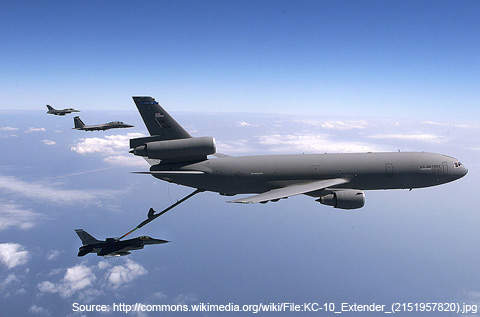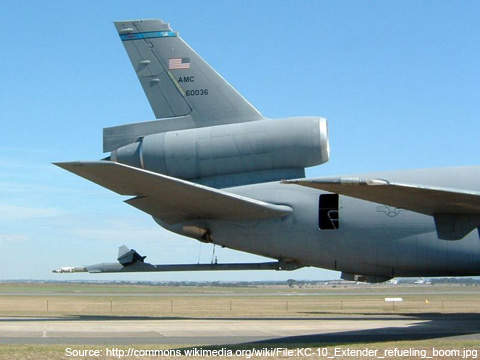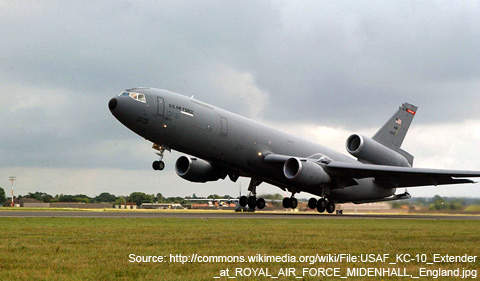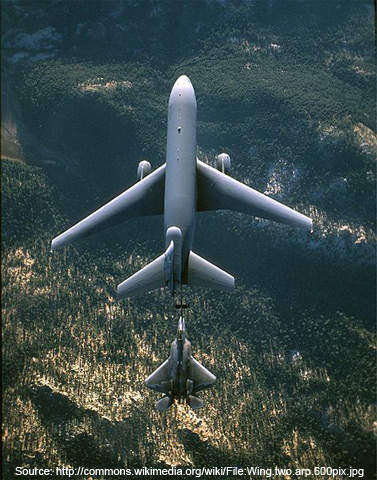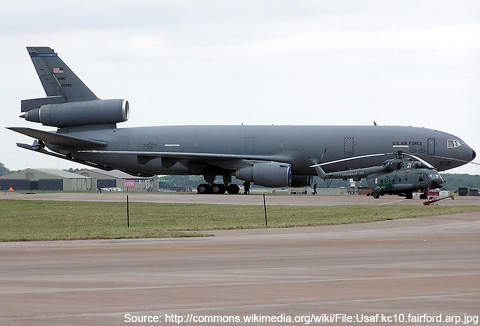The KC-10 Extender is an air-to-air refuelling tanker aircraft. The triple engined aircraft is in use with US armed forces and other coalition forces. The Extender can be used for cargo and passenger transport.
About 60 KC-10 tankers are operational worldwide. The first flight of the KC-10 took place in July 1980. The first refuelling mission was performed with the C-5 Galaxy aircraft in October 1980 and it entered service in March 1981. The 60th KC-10 was delivered in November 1988.
KC-10 tanker refuelling
Refuelling can be performed through the boom method or a hose and drogue centerline system.
The boom operator, which is located at the rear side of the aircraft’s cockpit, controls the refuelling operations through a digital fly-by-wire system.
The operator can monitor the receiver aircraft through a broad window. The receiver aircraft accepts fuel at the rate of 1,100 gallons per minute via the boom refuelling method.
The KC-10 is fitted with wing-tip hose and drogue air refuelling pods. The receiving aircraft approaches the tanker and its probe makes contact with a hose reeled out and trailing from the tanker. The hose and drogue refuelling system can transfer fuel at the maximum rate of 470 gallons (1,786l) per minute. The automatic load alleviation system and independent disconnect system offers safety and aids in refuelling operations.
Design
The aircraft was designed to enhance global mobility for the US armed forces by refuelling the fighter and cargo lift aircraft. The KC-10 can also perform medical evacuations by migrating litter and ambulatory patients through patient support pallets. The aircraft is equipped with a lighting system to operate during the night.
Development of the KC-10 Extender tanker
The KC-10 is derived from its predecessor McDonnell Douglas DC-10-30CF (convertible freighter) airliner. The KC-10 Extender is designed and manufactured by Boeing Integrated and Defence Systems to meet the requirements of the US Air Force.
Modifications made to the DC-10-30CF include a boom control station and three extra fuel tanks underneath the main deck, and the removal of cargo doors and windows.
In 2009, Northrop Grumman was awarded a nine-year $3.8bn contract by the US Air Force to offer logistic support to its KC-10 fleet. Partners include AAR, Chromalloy Gas Turbine and MTU Maintenance.
Boeing will upgrade its 59 KC-10 tanker fleet with an advanced communication, navigation, surveillance and air traffic management (CNS or ATM) system as part of a $216m contract by the US Air Force in June 2010.
The upgraded aircraft underwent its first flight test in 2012 at the San Antonio facility. The modified final KC-10 will be delivered to the US Air Force in 2015.
The US Air Force contracted Rockwell Collins on 25 July 2011 to overhaul its KC-10 fleet under the Communication, Navigation, Surveillance / Air Traffic Management (CNS / ATM) Cockpit Modernization Program.
Under the $160m contract, Rockwell will provide systems integration for KC-10. Rockwell will also supply avionics including flight management systems, displays, data link communications and surveillance systems.
Features of the KC-10 tanker
The KC-10 features a large cargo compartment in which fighter unit support load can be conciliated. Powered rollers and winches fitted in the compartment allow the aircraft to carry heavy loads. It can accommodate 75 passengers and 160,200kg (twice of KC-135) of fuel.
The aircraft is equipped with three main fuel tanks for refuelling operations. It is also fitted with three additional fuel tanks under the cargo floor. The six tanks perform refuelling operations more efficiently than KC-135 Stratotanker. It has the double the fuel capacity of the KC-135.
Cockpit
KC-10 has a glass cockpit with four seats meant for the pilot, co-pilot, flight engineer and boom operator. The pilot and co-pilot sit at the front of the cockpit and just behind it is a seat reserved for the flight engineer.
The boom operator sits at the outer corner of the flight engineer’s seat.
Additional seats and bunks can also be included in the cockpit for accommodating extra crew members.
Two flight nurses and three medical technicians can be accommodated during aeromedical evacuations.
Engines
The KC-10 Extender is powered by three General Electric CF6-50C2 turbofan engines. Each engine can produce 52,500lb (23,625kg) of thrust. The engine is 183in (4.64m) long. Its maximum diameter is 105in (2.66m). The dry weight of the engine varies from 8,966 to 9,047lb.
Performance
The aircraft can climb at the rate of 34.9m/s. Its maximum speed is 996km/h. The normal and ferry range of the KC-10 are 7,081km and 18,507km respectively.
The KC-10 Tanker service ceiling is 12,727m. The extender weighs around 108,890kg and its maximum take-off weight is 265,500kg.
The Global Military Aircraft Market 2011-2021
This project forms part of our recent analysis and forecasts of the global military aircraft market available from our business information platform Strategic Defence Intelligence. For more information click here or contact us: EMEA: +44 20 7936 6783; Americas: +1 415 439 4914; Asia Pacific: +61 2 9947 9709 or via email.

